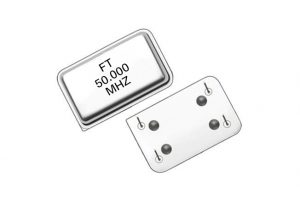Clock Oscillators: Their Types, Characteristics and Applications.
What is Clock Oscillator?
An electronic oscillator circuit known as a clock oscillator produces a periodic signal needed to coordinate electronic devices. The oscillator circuit establishes the signal’s frequency.This oscillator circuit produces a periodic square wave (typically) in the digital domain. This particular frequency is employed for timing purposes or as a reference for digital electronics equipment.
How does a clock oscillator work?
An oscillator is a circuit that operates without any input and produces a periodic, repeated, and oscillating waveform. Essentially, oscillators transform a DC source’s unidirectional current flow into an alternating waveform with a particular wavelength, as determined by the elements in its circuit. A clock oscillator works by alternately turning on and off a group of transistors to create a waveform or pulse train that repeats regularly. The component that creates a periodic output signal is known as an oscillator. Oscillators are frequently utilized as essential components in other circuits, including filters.
The applications of a Clock oscillator
The most popular type of oscillator is the conventional clock oscillator, which finds employment in almost every area of the electronics sector. A reference frequency that is utilized for timing purposes is established using the oscillator. The computer’s event sequencer is a typical application. An amplifier plus a feedback network that chooses a part of the amplifier output and feeds it back to the amplifier input make up a crystal-controlled oscillator in most cases.
Fundamental requirements for oscillation in an oscillator include:
- The oscillatorloop losses surrounding the open loop gain must be more significant than. The phase shift must be either 0 or 360 degrees around the oscillator loop. Various waveforms can be produced using an oscillator. Sinusoidal and square waveforms are the two most typical waveform types produced by oscillators.
- Due to their small size and affordable price, Electronic warfare systems, communication systems, guidance systems, microchips, micro-controllers, space monitoring systems, computer systems, detectors, discs, information technology, and other systems all make extensive use of them.
- Numerous electronic equipment, such as radios, TVs, cell phones, and computers, employ oscillators. Many other types of signals, including audio, video, and even microwave signals, are produced by oscillators.
What are the Advantages of using a clock oscillator?
A number of different electronic equipment serves as a time reference. Over other oscillators, a clock oscillator offers various benefits. It is far more accurate and jitter-free (variation in the timing of the output signal). It serves as a timekeeper or a timing reference for other circuits. They are extensively utilized in timekeeping devices like digital audio players, laptops, quartz wristwatches, and mobile phones. Comparing a clock oscillator to other timekeeping techniques, there are several benefits. They are used in a wide variety of applications, including clocks, watches, computers, radio receivers, television sets, portable electronic devices, timekeepers, and cell phones.
Types of Clock oscillator:
There are many types of clock oscillators which are given below:
- Crystal oscillator:
Using the piezoelectric effect of a vibrating crystal constructed of piezoelectric material, and mechanical oscillator that produces an electrical signal with a highly accurate frequency is called a crystal oscillator. They are frequently utilized in both scientific and industrial equipment as well as consumer devices. They are frequently found in electrical devices, including clocks, televisions, computers, radio receivers, and timers. This frequency keeps track of time, gives digital integrated circuits a reliable clock signal, and maintains radio transmitter and reception frequencies. They are reliable and stable in a variety of working environments and temperatures. They are frequently utilized in both scientific and industrial equipment as well as consumer devices.
- Quartz oscillators
Electronic devices called quartz oscillators that provide exact frequencies. Clocks, computers, radios, and a wide range of other electrical equipment all use them. Because they offer a consistent and precise frequency that can be used to control other electronic components, quartz oscillators are crucial for many applications in electronics. Much electronic equipment, such as computers, mobile phones, and radios, employ quartz oscillators to maintain the correct time. They enable accurate timekeeping in numerous electronic gadgets. They are necessary to make sure that these gadgets maintain precise time. Many electrical devices employ quartz oscillators to keep time, typically in conjunction with a crystal oscillator. Additionally, they are utilized to produce a precise time-based for digital electronics. Quartz oscillators are crucial parts of many electronic devices because they are reliable, accurate, and reasonably priced. Quartz oscillators are essential parts of electrical equipment because they provide an extremely accurate and steady time-based. They are used in many electronic devices, including clocks, watches, computers, cellphones, and many more.
Why do we need a clock oscillator?
An electronic oscillator circuit known as a clock oscillator produces a signal with a specific frequency. This signal is used to track time or give digital logic circuits a reliable clock signal. It is necessary if you wish to keep track of time or give digital logic circuits a reliable clock signal. When a specific amount of time has passed, this oscillator circuit generates a periodic signal that alerts you to the change. To produce a signal with a very exact frequency, this circuit often uses an electronic oscillator like a crystal oscillator or an LC oscillator.
Conclusion
A tool used to create periodic signals is an oscillator. An electrical circuit that produces a periodic signal is called a clock oscillator. The phrase describes a frequency-controlled oscillator in digital electronics. An oscillator for a clock generates a predictable stream of pulses. Additionally, they can be found in scientific apparatus, musical instruments, and mechanical .Oscillators are employed in many electronic circuits, including those in radios, televisions, computers, and mobile phones. Products from ChipSun are created from high-quality components and provide satisfied consumers. Purchase items from our website at a reasonable price. Following the purchase of the items, you will be happy with us. clocks.

